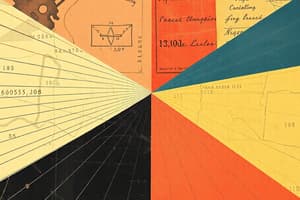Podcast
Questions and Answers
What does the Alternate Interior Angles Converse Theorem state?
What does the Alternate Interior Angles Converse Theorem state?
- If two lines are perpendicular to the same line, then the two lines are parallel to each other.
- If two lines intersected by a transversal form congruent alternate interior angles, then the lines are parallel. (correct)
- If two lines intersected by a transversal form supplementary same-side exterior angles, then the lines are parallel.
- If two parallel lines are intersected by a transversal, then the corresponding angles are congruent.
What does the Alternate Exterior Angles Theorem state?
What does the Alternate Exterior Angles Theorem state?
- If two lines intersected by a transversal form congruent alternate exterior angles, then the lines are parallel.
- If two lines intersected by a transversal form supplementary same-side interior angles, then the lines are parallel.
- If two parallel lines are intersected by a transversal, then the same-side interior angles are supplementary.
- If two parallel lines are intersected by a transversal, then the alternate exterior angles are congruent. (correct)
What does the Alternate Interior Angles Theorem state?
What does the Alternate Interior Angles Theorem state?
- If two lines intersected by a transversal form complementary angles, then the lines are parallel.
- If two lines are perpendicular to the same line, then the two lines are parallel to each other.
- If two parallel lines are intersected by a transversal, then the alternate interior angles are congruent. (correct)
- If two lines intersected by a transversal form a right angle, then the lines are parallel.
What does the Alternate Exterior Angles Converse Theorem state?
What does the Alternate Exterior Angles Converse Theorem state?
What does the Corresponding Angles Theorem state?
What does the Corresponding Angles Theorem state?
What does the Corresponding Angles Converse Theorem state?
What does the Corresponding Angles Converse Theorem state?
What does the Perpendicular/Parallel Line Theorem state?
What does the Perpendicular/Parallel Line Theorem state?
What does the Same-Side Exterior Angles Theorem state?
What does the Same-Side Exterior Angles Theorem state?
What does the Same-Side Interior Angles Theorem state?
What does the Same-Side Interior Angles Theorem state?
What does the Same-Side Interior Angles Converse Theorem state?
What does the Same-Side Interior Angles Converse Theorem state?
What does the Same-Side Exterior Angles Converse Theorem state?
What does the Same-Side Exterior Angles Converse Theorem state?
What is a transversal?
What is a transversal?
Flashcards are hidden until you start studying
Study Notes
Key Theorems about Parallel Lines and Angles
- Alternate Interior Angles Converse Theorem: Congruent alternate interior angles imply that the two intersected lines are parallel.
- Alternate Exterior Angles Theorem: Parallel lines that are intersected by a transversal will have congruent alternate exterior angles.
- Alternate Interior Angles Theorem: The angles formed inside two parallel lines by a transversal are congruent.
- Alternate Exterior Angles Converse Theorem: If alternate exterior angles formed by two intersected lines are congruent, the lines are parallel.
- Corresponding Angles Theorem: When parallel lines are intersected by a transversal, each pair of corresponding angles is congruent.
- Corresponding Angles Converse Theorem: Congruent corresponding angles indicate that the two lines intersected by a transversal are parallel.
- Perpendicular/Parallel Line Theorem: Two lines perpendicular to the same line are parallel to each other.
- Same-Side Exterior Angles Theorem: For parallel lines crossed by a transversal, same-side exterior angles are supplementary (sum to 180°).
- Same-Side Interior Angles Theorem: When a transversal intersects two parallel lines, the same-side interior angles are supplementary.
- Same-Side Interior Angles Converse Theorem: Supplementary same-side interior angles from two intersected lines suggest that the lines are parallel.
- Same-Side Exterior Angles Converse Theorem: If same-side exterior angles are supplementary, the intersected lines are confirmed as parallel.
- Transversal Definition: A transversal is a line that crosses two distinct lines in the same plane, assisting in determining whether these lines are parallel.
Studying That Suits You
Use AI to generate personalized quizzes and flashcards to suit your learning preferences.




